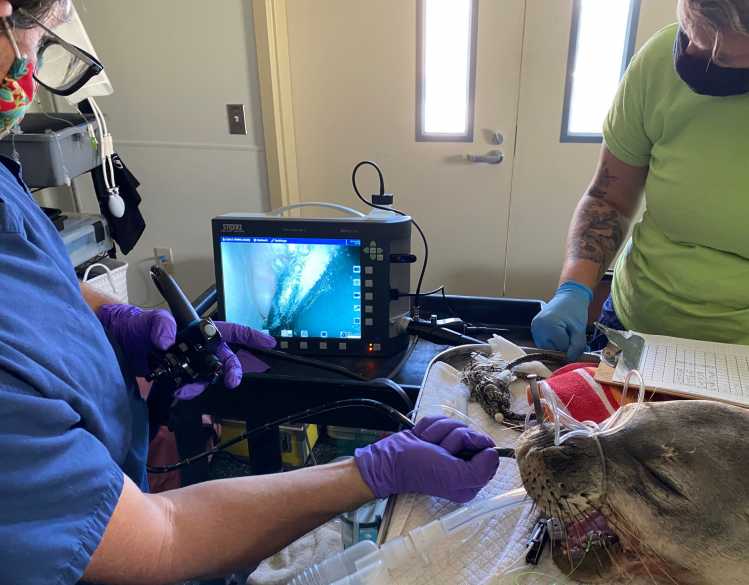
Endangered Hawaiian Monk Seal Transported from Oʻahu to The Marine Mammal Center for Life-Saving Care
- Species conservation
- Entanglement
- Ocean trash
Veterinary experts perform complex procedure to remove ingested fishing gear from juvenile male monk seal at the Center’s Hawai’i Island based hospital
The Marine Mammal Center, the world’s largest marine mammal hospital, has admitted an endangered Hawaiian monk seal suffering from fishing gear ingestion and moderate malnutrition at the Center’s hospital in Kailua-Kona. The juvenile male monk seal, known by researchers as both R7AF and N2, is currently in stable condition.
“The ingested fishing gear clearly impacted this monk seal’s condition and we’re hopeful thanks to a successful procedure, that this animal is on the road to a full recovery,” says Dr. Sophie Whoriskey, the Center’s Hawaiian Monk Seal Conservation Veterinarian. We’re proud to be able to support patients like R7AF as the only partner organization permitted by NOAA Fisheries to treat and rehabilitate Hawaiian monk seals.
We will do everything we can to give this endangered animal a second chance to return to his ocean home.
Hawaiian monk seals suffer from very high rates of entanglement in ocean trash and fishing gear, as well as ingestion of fishing hooks.
During the seal’s initial critical care period, Center experts stabilized the animal before performing a successful procedure to remove an ingested hook from his stomach. During the procedure, the team also took a series of blood samples and a fecal sample for further analysis.
The Center’s veterinary team noted that R7AF was moderately malnourished but is alert and quiet. The plan is to slowly begin offering sustainably caught live and dead fish feedings as well as subcutaneous fluids to help boost his nutritional status and hydration in the coming days.

A Complex Rescue on Oʻahu
R7AF made the trip from Oʻahu to the Center’s hospital thanks to a combined effort from local responders.
On January 22, NOAA received a report via the NOAA marine wildlife hotline of a seal on the Ka Iwi Coastline with a wire fishing leader and a swivel hanging from its mouth. NOAA Fisheries staff responded to evaluate the seal’s condition, but it was not possible to attempt to remove the gear at the time due to logistical constraints.
Hawaii Marine Animal Response (HMAR) then deployed 13 people, for 54 hours, spanning 5 days to look for and ultimately find the seal at Hanauma Bay on January 27. Trained experts from NOAA and HMAR performed a successful rescue that day, and the response team transported the seal to NOAA's Inouye Regional Center.
Due to the seal’s condition and need for long term rehabilitation after the endoscopy procedure, NOAA initiated travel plans to bring the seal to The Marine Mammal Center’s hospital on Hawai’i Island. The U.S. Coast Guard airlifted the seal on January 28 via a C-130 aircraft, as part of training operations.
Learn More About Hawaiian Monk Seals
{"image":"\/Animals\/Wild\/Hawaiian monk seal\/hawaiian-monk-seal-shutterstock.jpg","alt":"Hawaiian monk seal at the shoreline","label":"Pinnipeds","title":"Hawaiian Monk Seal","link_url":"\/animal-care\/learn-about-marine-mammals\/pinnipeds\/hawaiian-monk-seal","type":"page"}

{"image":"\/Animals\/Wild\/Hawaiian monk seal\/cropped-images\/HMS-wild-NOAA-4-832-3197-1474-1603733454.jpg","alt":"Two Hawaiian monk seals sleeping on the beach.","label":"Conservation","title":"Hawaiian Monk Seal Conservation","link_url":"\/science-conservation\/conservation\/hawaiian-monk-seal-conservation","type":"page"}

{"image":"\/Animals\/Patients\/Hawaiian monk seals\/2015\/hms-pearl-by-julie-steelman-c-the-marine-mammal-center-noaa-permit-18786.jpg","alt":"Hawaiian monk seal Pearl","title":"Understanding Endangered","link_url":"https:\/\/www.marinemammalcenter.org\/publications\/understanding-endangered","label":"Online Learning Resource","type":"publication"}

{"image":"\/Animals\/Patients\/Hawaiian monk seals\/2016\/hms-nihoole-5-photo-c-noaa-permit-16632.jpg","alt":"Hawaiian monk seal Niho'ole","title":"Aloha \u02bb\u0100ina","link_url":"https:\/\/www.marinemammalcenter.org\/publications\/aloha-aina","label":"Online Learning Resource","type":"publication"}

Since 2014, the Center has rehabilitated and released 36 monk seals, most of which have been rescued from and returned to the Northwestern Hawaiian Islands as part of the Center’s partnership with NOAA Fisheries, utilizing resources in the area to identify seals in need, rescue and rehabilitate them, and give them a second chance at life.
The Center’s partnership with NOAA Fisheries and other cooperating agencies is more important than ever to prevent this endangered species from becoming extinct. Approximately 30 percent of monk seals that are alive today are due to conservation efforts led by NOAA Fisheries and partners like The Marine Mammal Center.
Header image: photo by Sophie Whoriskey © The Marine Mammal Center / NOAA permit #18786
Yes, I want to save a life!

Yes, I want to save a life!
You’ll be giving sick and injured animals the best possible care at the Center’s state-of-the-art hospital. With your gift today, you are giving a patient a second chance at life in the wild.
See Our Latest News
{"image":"\/People\/Action\/Veterinary care\/cropped-images\/Harris_Green turtle_TMMC-0-0-1270-992-1767649941.jpg","alt":"Heather Harris","title":"Seattle Aquarium Awards Dr. Heather Harris With Prestigious Conservation Research Award","link_url":"https:\/\/www.marinemammalcenter.org\/news\/seattle-aquarium-awards-dr-heather-harris-with-prestigious-conservation-research-award","label":"In the News","date":"2026-01-05 04:48:00"}

Seattle Aquarium Awards Dr. Heather Harris With Prestigious Conservation Research Award
January 5, 2026
Read More{"image":"\/People\/Action\/Veterinary care\/cropped-images\/harris-teaching-tube-feeding-0-0-1270-992-1767650122.jpg","alt":"A veterinarian and two trained volunteers tube feed an elephant seal pup.","title":"Training College Students in Marine Mammal Health","link_url":"https:\/\/www.marinemammalcenter.org\/news\/training-college-students-in-marine-mammal-health","label":"News Update","date":"2026-01-05 04:48:00"}

{"image":"\/Animals\/Patients\/Harbor seals\/2013\/cropped-images\/hs-bogey-photo-by-Ingrid-Overgard-c-the-marine-mammal-center-382-0-2914-2276-1605061447.jpg","alt":"harbor seal Bogey","title":"Top Eco Friendly Valentine\u2019s Day Gifts","link_url":"https:\/\/www.marinemammalcenter.org\/news\/top-eco-friendly-valentines-day-gifts","label":"News Update","date":"2026-01-01 01:00:00"}

{"image":"\/Animals\/Patients\/Harbor seals\/2020\/cropped-images\/hs-barnwood-by-bill-hunnewell-c-the-marine-mammal-center-315-0-3299-2577-1607370547.jpg","alt":"harbor seal Barnwood","title":"Last-Minute Gift Guide \u2013 Top Gifts that Give Back to Marine Animals","link_url":"https:\/\/www.marinemammalcenter.org\/news\/last-minute-gift-guide","label":"News Update","date":"2025-12-18 01:00:00"}

Last-Minute Gift Guide – Top Gifts that Give Back to Marine Animals
December 18, 2025
Read More